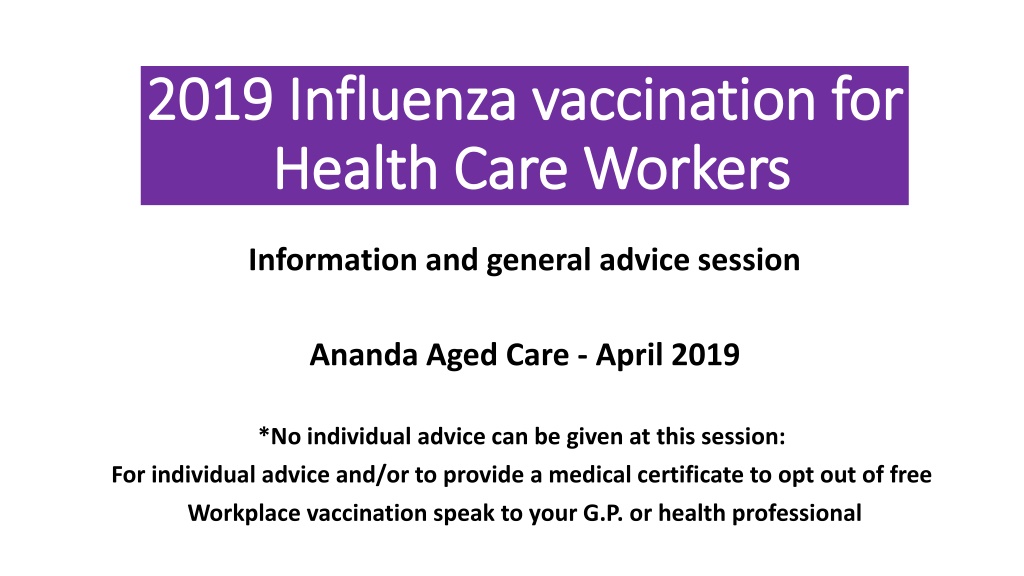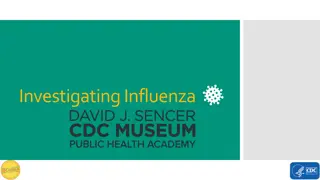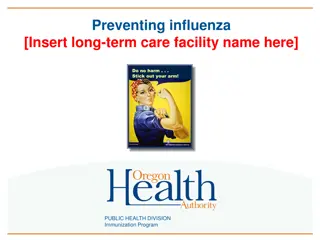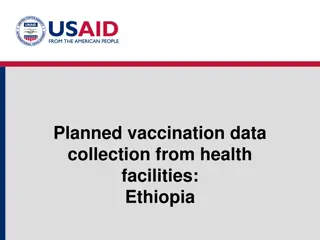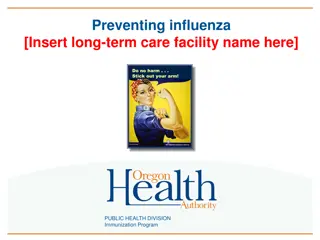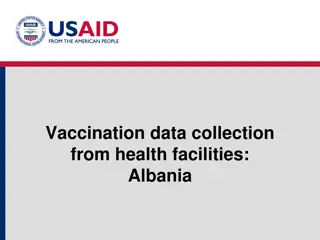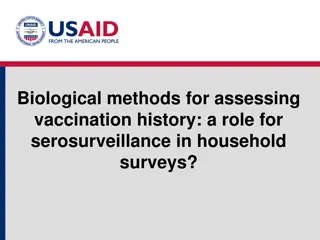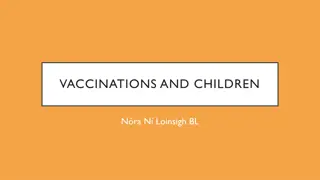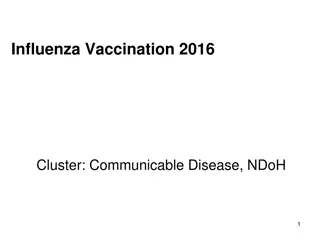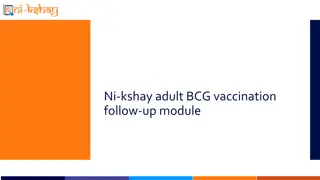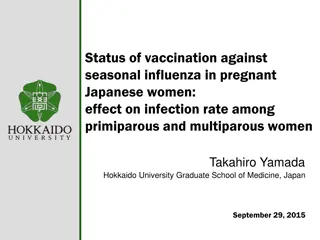Importance of 2019 Influenza Vaccination for Health Care Workers
Influenza, commonly known as the flu, is a contagious respiratory illness caused by influenza viruses that can spread through aerosols or surface contact. Common symptoms include fever, headache, fatigue, muscle pain, cough, and sore throat. The flu can be severe, leading to hospitalizations and even deaths, especially among vulnerable populations. Vaccination is highly recommended to prevent the spread of the flu and protect high-risk individuals. The program emphasizes the importance of influenza vaccination for health care workers and the general public.
Uploaded on Oct 10, 2024 | 0 Views
Download Presentation

Please find below an Image/Link to download the presentation.
The content on the website is provided AS IS for your information and personal use only. It may not be sold, licensed, or shared on other websites without obtaining consent from the author. Download presentation by click this link. If you encounter any issues during the download, it is possible that the publisher has removed the file from their server.
E N D
Presentation Transcript
2019 Influenza vaccination for 2019 Influenza vaccination for Health Care Workers Health Care Workers Information and general advice session Ananda Aged Care - April 2019 *No individual advice can be given at this session: For individual advice and/or to provide a medical certificate to opt out of free Workplace vaccination speak to your G.P. or health professional
What is influenza (the flu) A contagious illness of the respiratory tract, caused by infection with influenza viruses Spread by aerosol (sneezing, coughing, talking) or touching infected surfaces Virus can survive in the air for 1-2 hours, and on hard surfaces for 8-24 hours Usually more severe, and lasts longer than other viral respiratory illnesses
Common symptoms of the flu Symptom Influenza Cold Fever Headache Extreme fatigue Aches and pains/muscle pain Tiredness and weakness Cough/chest discomfort Runny or stuffy nose Sneezing Sore throat
People with influenza can be infectious to others for days before symptoms start & about a week after Children may shed for longer than 7 days and effectively spread the virus ( super spreaders ) Vaccination helps protect individuals from Spreading the flu and reduces transmission to vulnerable people such as infants, older adults, and immunocompromised individuals
The flu in normal years causes 2,500 3,500 DEATHS 18,000 hospitalisations 350,000 GP visits Most not confirmed as not tested People at increased risk of complications are more likely to be hospitalised or die from influenza
Influenza vaccination is strongly recommended, provided under the Australian National Immunisation Program (NIP) and should be actively promoted for Older adults aged 65 years and above Pregnant women Helps protect the woman, her unborn child, and the infant from 0-6 months of age People 6 months of age with medical conditions placing them at risk of serious complications of influenza
Our role in preventing flu outbreaks HCWs can transmit the influenza virus to patients in their care, many of whom are at risk of developing influenza complications Even with mild or atypical influenza symptoms, HCWs can shed the virus and infect others HCWs may also continue to work when feeling ill X Annual immunisation of healthcare workers helps prevent influenza infection & and minimises exposure of vulnerable residents
Resident focused care = above all do no harm
Influenza vaccination is strongly recommended for anyone 6 months of age who wants to reduce the risk of contracting or transmitting influenza. (W.H.O. & ATAGI)
Flu is here all the time, but. In temperate areas flu has a different peak but in SA it is usually Agust/September & April/May the best time to vaccinate In 2017 rates were highest since 2009 a pandemic year Most deaths are in people aged >75
Types of flu There are three types of influenza viruses; A, B and C Influenza A and B cause most disease in humans Iinfluenza viruses are divided into sub-types, based on two proteins found on the virus surface Haemagglutinin & Neuraminidase Influenza B viruses are divided into two lineages Victoria & Yamagata Quadrivalent influenza vaccines (QIVs) contain both sub- types of influenza A virus and both lineages of influenza B virus
It is difficult to predict which types of influenza virus will be most prevalent each season In Australia, the proportion of disease due to: Influenza A versus influenza B viruses and B- Yamagata versus B-Victoria lineagesvaries from year to year
Types of flu vaccine Quadrivalent influenza vaccines (QIVs) contain two influenza A virus sub-types + two (both) influenza B virus lineages for under 65s Trivalent influenza vaccines (TIVs) contain two influenza A virus sub-types + one of the two influenza B virus lineages fo over 65s
Who should NOT have the flu vaccine? Postpone with acute severe febrile illness Use caution in people with coagulation disorders, as bleeding can occur People with a history of Guillain-Barr Syndrome (GBS) If a documented previous anaphylactic reaction (difficulty breathing, hospitalisation etc) to the flu vaccine, or any of its ingredients If no previous severe reaction but concerned (eg ? an egg allergy) go to GP and have it there or get a medical certificate/note stating not advisable to have it
Common reactions to the flu vaccine Adults Children 3-17 yrs Fatigue Fatigue Muscle pain (myalgia) Muscle pain (myalgia) Injection site pain Injection site redness Injection site swelling Irritability
Take home messages Influenza is a highly contagious disease which can cause hospitalization and even death especially in vulnerable groups like children and aged people This may be a very bad flu year The flu vaccine is the best protection you can have so have it! It is generally safe and there are few and minor side effects Those who should not have the vaccine are rare they should get a certificate from their GP and not have the vaccine Those with concerns about the vaccine should speak to their GP and have the vaccine at their GP surgery if needed
